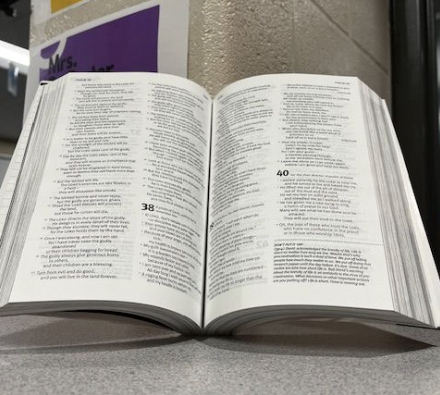A GPA (or Grade Point Average) is a grading system where more points are awarded for earning a higher letter. Specifically, a student can earn four points for an A, three points for a B, two points for a C, one point for a D, and no points are awarded for an F. A weighted GPA expands on the original system by awarding more points, varying by a school district’s weight formula, for more rigorous classes.
Currently the USD 230 school district does not weigh any grades, so whether a student is in regular chemistry or honors chemistry, an A earned in either class

carries the same weight.
“Kids come to counselors hung up on a GPA so they want to drop courses that are difficult because they don’t want that to affect their GPA. Kids very much see their status as their GPA,” Katie George, counselor, said.
For students, a number representing all of their academic accomplishments is an all-too-common issue.
“It’s kind of detrimental to have your status as a student be defined by a single number,” Adelyn O’Hanlon, 11, said. “It doesn’t show what you know at all.”
O’Hanlon is familiar with the GPA system and its pitfalls, as they’ve taken all honors and AP courses available to them. With a high amount of course load comes a high amount of stress, especially without the cushion of a weighted GPA system.
Maya Lozano, 11, who has taken nearly every advanced course available to them said, “I think I would’ve been less stressed about my course load [if there were weighted GPAs] because there wouldn’t have been as much pressure around my 4.0.”
While still a supporter of weighted grades, Stephanie Hojnacki, math teacher, wonders if it’s the best solution for everyone.

“We are all so uniquely motivated, and our interests are so unique that having only a couple options of how to demonstrate that is a very difficult situation,” Hojnacki said. “Instead of freaking out about tracking and labeling and catering to a specific group of kids, I think it’s not about being low-achieving or high-achieving, it’s about, ‘are we providing this option for this type of kid and their abilities and this type of kid and their abilities?’”
One current solution to this question is the creation and expansion of CTE programs, in not just the district, but across the region.
“If you separate the idea of a standard high school from a CTE-type high school, you’re allowing kids this alternate route that is equivalent in productivity, successes, and notability as a regular high school route that takes you to a university,” Hojnacki said.
A change in the current grading scale will ultimately only allow for expansion of AP and honors course selection.
“Weighted GPAs encourage students to actually take those classes,” O’Hanlon said. “It would also allow us to have more honors and AP classes because more students would take them, so it would feed back into itself.”
However, without a gauge at all, students might not receive a balanced education.
“When you consider the GPA scale, there are nuances to it that are flawed. However, without it, I feel like you start dropping the ball in areas that you’re not currently interested in… Let’s say I don’t love math, so I’m not going to push myself in math. Then you lack this foundation that is full and you end up with holes that will prevent you from having more options down the road,” Hojnacki said.
While not perfect, weighted GPAs can offer students greater opportunities and more options for the future. Many students desire change as the selection of rigorous classes expands.











![Peering through their microscopes, [Brock] Laplante’s freshman Biology class has a hard time pretending they’re not interested. From sharp angles to swirling cells, there’s no predicting what could be seen.](https://stampedenews.net/wp-content/uploads/2025/10/Screenshot-2025-10-03-at-10.56.07-AM.png)
